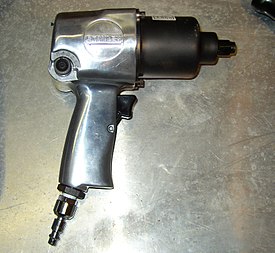
Back Impulsschrauber German Llave de impacto Spanish آچار بکس ضربهای FA Boulonneuse French インパクトレンチ Japanese 임팩트 렌치 Korean Muttertrekker NB Гайковёрт Russian Mutterdragare Swedish 气动扳手 Chinese
This article needs additional citations for verification. (September 2008) |

An impact wrench (also known as an impactor, impact gun, air wrench, air gun, rattle gun, torque gun, windy gun) is a socket wrench power tool designed to deliver high torque output with minimal exertion by the user, by storing energy in a rotating mass, then delivering it suddenly to the output shaft. It was invented by Robert H. Pott of Evansville, Indiana.[1]
Compressed air is the most common power source, although electric or hydraulic power is also used, with cordless electric devices becoming increasingly popular since the mid-2000s.[2]
Impact wrenches are widely used in many industries, such as automotive repair, heavy equipment maintenance, product assembly, major construction projects, and any other instance where a high torque output is needed. For product assembly, a pulse tool is commonly used, as it features a reactionless tightening while reducing the noise levels the regular impacts suffer from. Pulse tools use oil as a medium to transfer the kinetic energy from the hammer into the anvil. This gives a smoother impulse, a slightly lower torque to weight ratio and a possibility to design a shut off mechanism that shuts the tool down when achieving the correct torque. Pulse tools are not referred to as "impact wrenches" as the performance and technology are not the same.[according to whom?]
Impact wrenches are available in every standard socket wrench drive size, from small 1⁄4 in (6.4 mm) drive tools for small assembly and disassembly, up to 3+1⁄2 in (89 mm) and larger square drives for major construction.
In operation, a rotating mass is accelerated by the motor, storing energy, then suddenly connected to the output shaft (the anvil), creating a high-torque impact. The hammer mechanism is designed such that after delivering the impact, the hammer is again allowed to spin freely, and does not stay locked. With this design, the only reaction force applied to the body of the tool is the motor accelerating the hammer, and thus the operator feels very little torque, even though a very high peak torque is delivered to the socket. (This is similar to a conventional hammer, where the user applies a small, constant force to swing the hammer, which generates a very large impulse when the hammer strikes an object.) The hammer design requires a certain minimum torque before the hammer is allowed to spin separately from the anvil, causing the tool to stop hammering and instead smoothly drive the fastener if only low torque is needed, rapidly installing/removing the fastener.
- ^ US patent 2012916A, Robert H Pott, "Impact tool", issued 1935-08-27
- ^ "Side by side: Cordless impact wrenches". 25 December 2007. Archived from the original on 25 December 2007.